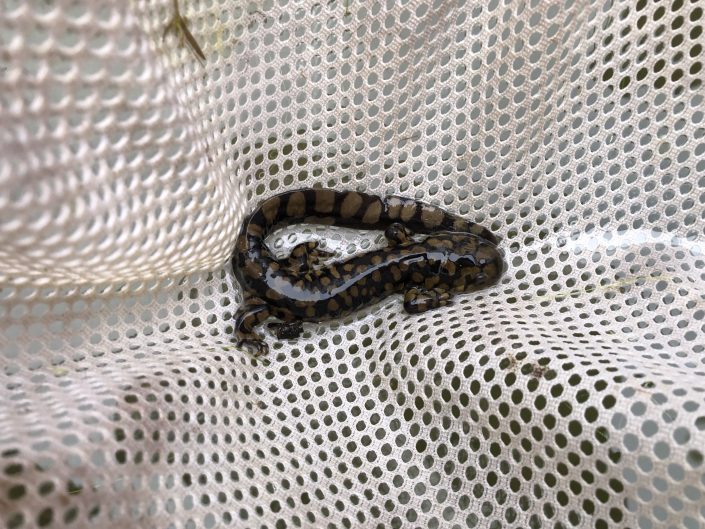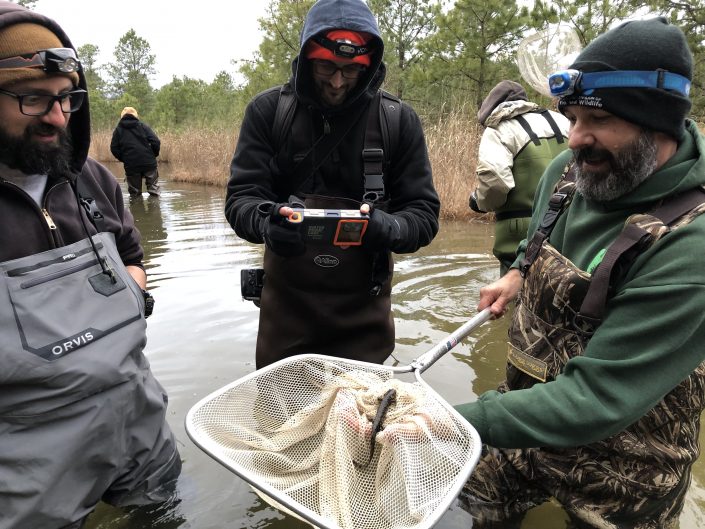Encouraging Development for Tiger Salamanders
By Christine Healy, Wildlife Biologist

In today’s world, it’s pretty difficult to think of a species that scientists are not concerned about in the face of climate change. The reasons are many and diverse, but in a state where 42% of municipalities are considered “coastal”, it comes as no surprise that sea level rise (SLR) is a big threat here- both to people and wildlife. When the average person imagines which species are most likely to be impacted by SLR, it’s likely that beach nesters, including piping plovers, immediately come to mind. Afterall, they occupy the same environments that recreationalists are worried about losing. Valid point- but they are not the only ones. Eastern tiger salamanders, one of New Jersey’s rarest amphibians, also make the list.
Like our other mole salamanders (spotted, blue-spotted, marbled, and Jefferson), Eastern tiger salamanders require access to temporary wetlands, called vernal pools, to successfully breed. The ephemeral nature of these water bodies is critical because it eliminates fish as potential egg predators and thus increases larval survival. While these salamanders spend much of the year in forested landscapes, adults return annually to their natal pools (in most cases) to reproduce. High fidelity to these sites can put these amphibians in danger if development occurs within their migration corridors or changes transpire within the pools themselves.

Eastern tiger salamanders in New Jersey are restricted to a small number of locations in Atlantic, Cape May, and Cumberland counties with a significant proportion falling below sea level. As sea level rises and storm severity increases, many of the inhabited pools are expected to become inundated with salt water. Amphibian skin is porous and extremely sensitive to pollutants and desiccation which would render impacted pools unusable.
In the mid-2010s, Conserve Wildlife Foundation worked with NJ Fish and Wildlife (NJFW) to create and enhanced vernal pools at higher elevations with the aim of facilitating tiger salamander management through egg translocation. The hope would be that hatching larvae would imprint on the engineered pools and establish new populations that would stand a better chance at weathering the impacts of climate change. Moving egg masses requires careful planning and consideration- this technique should only be attempted by state wildlife professionals. Additionally, there is no guarantee that larvae will succeed in new pools if water conditions and the structure of the surrounding landscape are not just so. While this effort was successful at one enhanced pool complex, no salamanders have been found at another site of man-made pools. NJFW has continued the initiative in recent years and in late 2023 their tenacity paid off. Tiger salamander egg masses were discovered for the first time in an inland pool where no adults had previously been found.

Senior wildlife biologist Larissa Smith continues to assist NJFW and USFWS monitor pools local to her and got me involved last year. I was thrilled to participate in surveys earlier this month targeting the newly established population as well as one of the origin pools for the transplanted eggs.
Tiger salamanders are winter breeders so surveying for adults and eggs is chilly business but that didn’t stop a large group of enthusiastic volunteers from turning up in chest waders with freshly charged headlamps to await Endangered and Nongame Species Program biologist, Bill Pitt’s instructions. Both sites included a complex of pools, so the team moved cautiously through the area, counting egg masses and scoping out adults. Though the new pool contained < 50 egg masses, recent rains made for deep water and lowered visibility, so it is possible that the count was an underestimation. The established pool returned a count > 200 which, again, was likely conservative due to high water levels. On both nights the team’s efforts were rewarded by some adult sightings which were a special treat given how late we were into the season.
While there are still many reasons to be concerned about tiger salamanders in New Jersey, the discovery of eggs at the inland pool is an encouraging development and lends support to future egg transplantation efforts. We look forward to seeing how this new population fares through continued survey involvement in years to come.
Discover more from Conserve Wildlife Foundation of NJ
Subscribe to get the latest posts sent to your email.